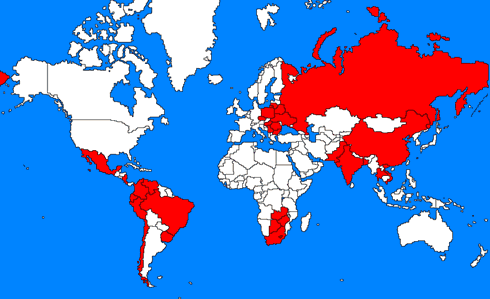In the past two decades, the international donor community has ushered in a historic expansion of global health programs. Through multi-country initiatives like the GAVI Alliance and the Global Fund for AIDS, TB, and Malaria an estimated 10 million deaths have been prevented by making life-saving vaccines and treatments available to individuals who would have otherwise gone without them. A remarkable accomplishment by any yardstick you use to measure.

At the same time, the world is rapidly changing. Below I outline three global trends that should be considered in global health policy for it to remain successful, effective and efficient.
1) Most poor people now live in middle income countries. Twenty years ago, 90 percent of poor people lived in poor countries (click here to see the World Bank classifications of low and middle income). So, when aid was directed at government programs in low-income countries it essentially also was directed at poor people. And the justification for aid was simple - no one could argue that governments in low-income countries should be doing more for their own impoverished populations because the governments simply didn't have it.
Now, most people living in poverty (defined as living on less than1.25 per day) reside in "middle-income countries,"according to Andy Sumner at the Institute for Development Studies in his recent paper Global Poverty and the New Bottom Billion, and brilliantly visualized here in a 4 minute video by Hans Rosling of the Karolinska Institute. Most of these poor people actually live in a few "middle-income" countries (China, India, Pakistan, Nigeria, and Indonesia) and only about one-quarter of the world's poor live in low-income countries.
This simple fact represents a big change in two decades and has potentially large implications for aid policies (discussed by The Guardian's Jonathan Glennie here and by Owen Barder here), not least of which will be the need to reconcile the humanitarian/social justice rationale traditionally used to fundraise for aid with this new reality. Will taxpayers in countries like the USA be as willing to provide aid to emerging market countries like China and India (with domestic space programs) as they were for consistently impoverished states like Mali and Haiti? Clearly, new research, policies, and even new mechanisms for directing aid may need to be considered for the decade ahead.
2) Child mortality is declining, at last. In 1990, an estimated 12.4 million children died. In May 2010, the medical journal The Lancet published World Health Organization estimates showing that in 2010, only 8.8 million children died (a decline of about 30%) and that the number of deaths due to the leading illnesses - pneumonia & diarrhea - had reached their lowest levels ever. The following month (also in The Lancet), Chris Murray and colleagues at the Institute for Health Metrics & Evaluation shaved another 1.1 million child deaths off the figure by projecting that in 2010 the figure would be down to 7.7 million child deaths. Projecting into 2015, we can expect many fewer child deaths than when most global health initiatives began.
The fundamental injustice of millions and millions of children dying from a lack of access to simple vaccines and treatments has been the long-standing cornerstone of efforts - both private and public - to raise funds for global health programs. While it is clear that there will continue to be major health and development disparities between the "haves" and "have-nots" of the world, the continued use of mortality disparities as the driver for funding these efforts will be increasingly difficult to maintain. Instead, a shift in focus to how global health aid helps to prevent suffering and make people and communities both more healthy and economically productive will be needed.
3) Health outcomes are driven by both health and non-health programs. This point is more speculative than the others in that it is supported at least as much by observations of what didn't work as what did. For example, consider the recent evaluation of UNICEF's Accelerated Child Survival and Development programme in west Africa by Jennifer Bryce and colleagues in The Lancet. This careful evaluation showed that child mortality declined in the intervention areas but it failed to show an impact of the programme because mortality fell just as fast in the non-intervention areas. Similar observations have been seen in an evaluation of the WHO's Integrated Management of Child Illness approach in Bangladesh.
In short, the lack of any difference between intervention and non-intervention areas indicates that something other than (or in addition to) these health programs is driving the declines in child mortality. Combine this observation with historical observations of declines in infant mortality in countries like the UK that occurred before large-scale health and immunization programs and the recent report that up to 50% of declines in child mortality are potentially due to improved education of girls and women. Together, it seems likely that it is the integration of economic growth, education and health programs (at least) that are driving health outcomes. In short, a new approach that puts global health in the context of a comprehensive development approach seems necessary to maximize health outcomes.
In 2011, substantial injustices in health access will remain between and within countries. Existing health initiatives like the Global Fund and the GAVI Alliance can be expected to continue improving the health and lives of millions of impoverished people. Indeed, many of the gains described above and projected between now and 2015 will require continued support for these global health programs.
However, the changes indicated by these trends require a response and now is the time to begin the debate on how to adapt our successful health programs. So in 2011, let's ramp up what's working now, but at the same time, begin building the evidence we need to inform meaningful new policies and aid instruments and begin setting realistically ambitious donor expectations for the period from 2015 onwards.
